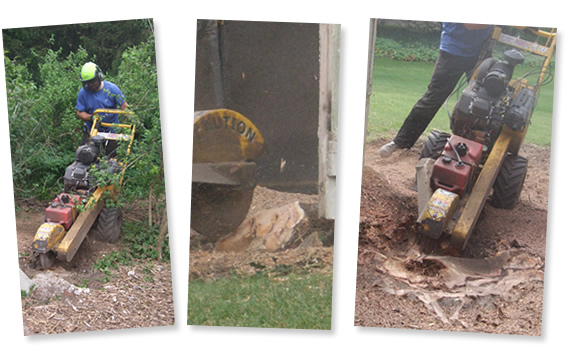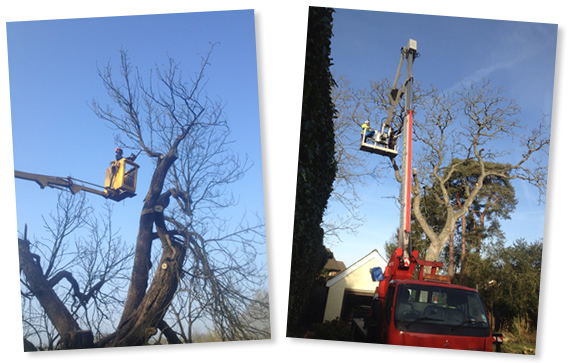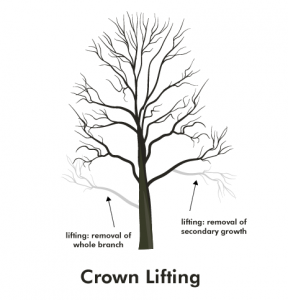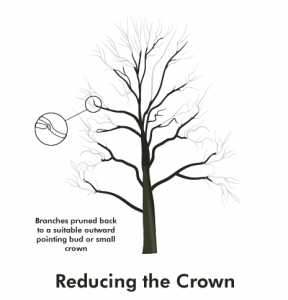Services
All work is carried out to BS 3998 2010 with £5 million public liability insurance.
Dead wooding/removal of dead wood
The dieback and shedding of branches are natural processes within the development and ageing of trees, and provide essential habitats or places of shelter(i.e. decaying wood and cavities) for many species of flora and fauna. Dead wood should be removed or shortened if they pose an unacceptable risk to people or property.
 Monolith (standing dead tree)
Monolith (standing dead tree)
Standing dead trees can retained by creating ‘monoliths’. This is where a decaying tree is made safe by reducing its height and spread, but left to decay in a standing position. These trees will then continue to support a range of species that are dependent on decaying wood and help to provide continuity of dead wood habitat until younger trees mature to a veteran status.
Where these trees are left for wildlife habitats, they should be inspected periodically and reduced in height if required to prolong the wildlife habitat (prevent felling).
Formative Pruning
The main aim of formative pruning is to produce a tree which in maturity will be free from any major physical weaknesses and will complement its surrounding landscape. Formative pruning is usually carried out on a three to five year cycle.
Crown Thinning
This is the process of removing not more than 30% of the leaf-bearing twig structure, from the whole of the tree not just the crown/canopy.
Crown Lifting
Crown lifting is the pruning/removal of the lower branches to achieve a desired vertical clearance above the ground. This is most common on roads and over footpaths/pedestrian walk ways. Removal of branches on older/mature trees can result in the potential of decay on the wounds on the stem(s).
Crown reduction and reshaping(Topping)
This process can reduce biomechanical stress by reducing both the leverage and sail area of the tree and can allow a tree to be retained in a confined space. It can also be used to shape the tree to a desired appearance or to suit its surroundings. The crown reduction should not be more than 30%, keeping the cuts small to reduce the chance of decay.
Selective Pruning(Lopping)
This might be the removal or shortening of branches on one side of the crown interfering with buildings, landscape features or other structures.
Pollarding
It has been common in Europe since medieval times and is practised today in urban areas worldwide, primarily to maintain trees at a predetermined height.
Traditionally, trees were pollarded for one of two reasons: for fodder to feed livestock, or for wood. Fodder pollards produced “pollard hay”, which was used as livestock feed; they were pruned at intervals of two to six years so their leafy material would be most abundant.
This is carried out on trees at the nursery, which are between 25mm to 50mm in diameter and often 2m-3m in height. Once initiated, a pollard tree should be maintained by cutting the new branches off on a 3-5 year cycle. Branches that grow after pollarding should normally be cut at their base to encourage the formation of a knuckle after a number of cycles. If the pollard has lapsed over many years, the crown should be reduced to the minimum required for that site. Retention of live stubs on lapsed pollards can often help to reduce the risk dysfunction and decay and weakness developing below the knuckles.
Stump Grinding
The stump grinding gives minimal disturbance to the surrounding ground. The grinder just needs 28 inches for access. We can grind most stumps of any size and position. 1m high mesh screens are put around the stump prior to grinding to contain the flying debris. The debris is usually put back in the hole (remains in situ); it is suitable for mulching or adding to your compost heap. The grinder has an adjustable handle to allow us to grind to a depth of 450-550mm and the unique “speed boat fuel tank” prevents fuel starvation.

Logs/Log splitting
We can supply mixed logs for open fires or Sweet chestnut logs for Wood Burners.
We also offer a Log splitting service with our 7ton mobile log splitter.
MEWP (mobile elevating work platform)
These can be used for dead or dangerous trees over garage roofs (as shown below, working around power lines)


